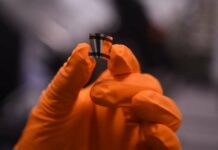Scientists used 3D bioprinting to sprout hair follicle-like structures into lab-grown human skin tissue in new research.
Researchers at the Rensselaer Polytechnic Institute in the US begin the procedure by “growing” samples of skin and follicle cells in a lab. After which, they combine them with unique proteins and other materials to make “bio-ink.”
This substance is then injected into lab-grown skin with an incredibly fine needle. They do it layer by layer, just like any other form of 3D printing. Eventually, the skin cells migrate to the channels surrounding the hair cells. Moreover, it forms hair follicle-like structures that are deeply implanted in the dermis layer of the skin.
Currently, these artificial tissues only last two to three weeks, insufficient time for hair strands to form. Nonetheless, given the hurdles previously encountered in this field, the team is happy with their success.
Dr Pankaj Karande at the Rensselaer Polytechnic Institute said,
The reconstruction of hair follicles using human-derived cells has historically been a challenge. Some studies have shown that if these cells are cultured in a three-dimensional environment, they can potentially originate new hair follicles or hair shafts, and our study builds on this work,”
He further added,
Our work is a proof-of-concept that hair follicle structures can be created in a highly precise, reproducible way using 3D-bioprinting. This kind of automated process is needed to make future biomanufacturing of skin possible,
While this may appear to be a treatment for hair loss at first glance, cosmetic concerns are not the primary purpose for the development of this innovation. Instead, the goal is to create lab-grown skin that behaves exactly like genuine human skin.
Hair not only makes skin appear more natural, but the follicles are important sites in the skin that create sweat, help regulate body temperature, and contain stem cells that aid in healing. Hair follicles are also vital for the absorption of topical medications and cosmetics; therefore their existence is critical in lab-grown skin used in drug testing.
That being said, other researchers are actively investigating the use of 3D-printing technology for future hair loss treatments.
The first author of the study, Dr Carolina Catarino said,
Right now, contemporary skin models — the engineered structures that mimic human skin — are quite simple. Increasing their complexity by adding hair follicles would give us even more information about how skin interacts with topical products,
Deepak Vashishth from Rensselaer Polytechnic Institute added,
Dr Karande’s lab is at the forefront of skin tissue engineering. This team has already successfully printed skin with working blood vessels, and this latest research is an exciting next step in developing and testing better treatments for burns and other skin conditions,




